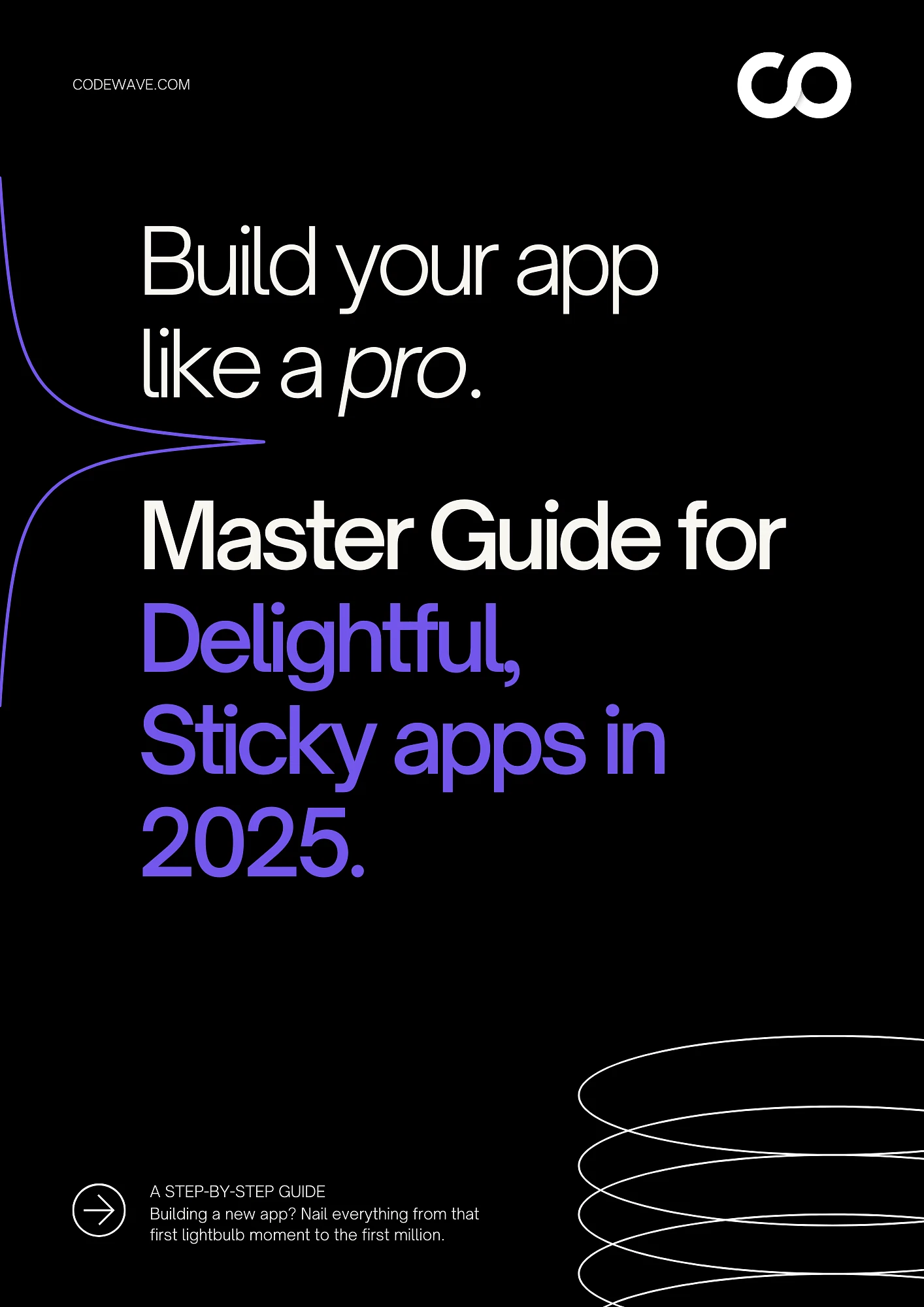In 2024, mobile apps generated over $935 billion in revenue, showcasing the immense potential in the app market. With mobile usage growing every year, apps are more crucial than ever for businesses seeking to connect with customers. But with so many apps available, creating one that stands out can be a challenge.
As a business leader, you need apps that don’t just work—they must drive engagement, sales, and streamline operations. But how do you choose the right idea that aligns with your business goals and meets market demands?
In this blog, we’ll explore the top app ideas for 2025, focusing on trends like AI, blockchain, sustainability, and AR/VR. We’ll outline practical, high-revenue potential app ideas to help you make informed decisions for your next big project.
Key Takeaways:
- High-Demand Markets: Focus on industries like fitness, mental health, and AR shopping for rapidly growing app opportunities.
- Tech-Driven Features: Incorporate AI, AR, VR, and blockchain to enhance user experience and provide personalized services.
- Monetization Models: Offer subscriptions, partnerships, and affiliate commissions to maximize revenue potential.
- Targeted User Needs: Address specific consumer pain points, such as eco-friendly products or efficient home maintenance.
- Scalable Solutions: Prioritize cross-platform development and integrate with popular tools for broader reach and faster growth.
Why 2025 is the Year for App Innovation?
The technology landscape in 2025 is defined by the convergence of AI, 5G, AR/VR, blockchain, and cross-platform development. These advancements create an ideal environment for new app opportunities that drive customer engagement, efficiency, and revenue growth.
Below are the key trends to watch and why 2025 is the perfect time to invest in app development:
- AI Everywhere: Generative AI and predictive analytics are revolutionizing how apps interact with users, enabling more personalized, data-driven experiences.
- 5G and Edge Computing at Scale: With 5G reaching over 75% penetration, real-time data processing and ultra-low latency will enhance user experiences, especially in AR/VR and IoT apps.
- AR/VR Going Mainstream: AR and VR are becoming integral to retail, training, and entertainment apps, providing immersive experiences that drive engagement and reduce costs.
- Blockchain and Web3 Integration: Blockchain technologies will offer secure, transparent transactions and decentralized solutions in industries like finance and supply chain.
- Cross-Platform Development Maturity: Cross-platform frameworks like Flutter and React Native will make app development faster and more cost-effective, allowing businesses to reach users across multiple platforms.
- Shifting Consumer Expectations: Consumers are demanding more personalized, private, and omnichannel experiences, creating a market for apps that provide seamless and engaging interactions.
With the latest tech presenting new opportunities, it’s crucial to focus on the areas where these advancements will have the greatest impact. Let’s now explore the top app ideas that will define this period.
Get your hands on The Ultimate Guide to Crafting Irresistible Apps in 2025. From your first spark of inspiration to hitting your first million, learn how to build your app like an expert.
Top App Ideas for 2025: High-Growth Potential Apps
As we move into 2025, several app ideas stand out for their potential to drive significant growth. These apps tap into emerging technologies and address key challenges across industries. By focusing on user needs and advance solutions, these app ideas offer excellent opportunities for businesses to gain strong market traction.
Let’s take a closer look at some of the most promising app concepts for 2025:
1. AI Fitness Coaching
The US fitness app market was valued at $3.6B in 2024 and is projected to grow to $10.3B by 2033. This shows the substantial opportunity for AI-driven fitness apps to tap into a growing demand for personalized health solutions.
Core Features:
- Integration with wearable devices (e.g., Apple Watch, Fitbit) to track fitness metrics.
- Real-time feedback and personalized workout plans based on data insights.
- Progress tracking and adaptive fitness recommendations.
Monetization Strategies:
- Subscriptions ($9.99/month), offering users premium features such as personalized coaching and detailed fitness analytics.
- B2B partnerships with corporate wellness programs, providing enterprise solutions to businesses looking to improve employee health.
Realistic Outcomes for Leaders:
For a successful AI fitness coaching app, expect $2M–$10M in annual recurring revenue (ARR), with 50,000–200,000 paid users. Retention rates are typically 20-30%, and integration with popular platforms like Apple Health or Google Fit can help accelerate growth.
Our blog post outlines a clear roadmap for effectively implementing AI in your business:
Steps for Successful AI Implementation Strategy in Your Business
2. Mental Health Companion
The global mental health apps market is projected to reach $17.5B in 2030, with North America accounting for 30-35% (~$2.7–$3B). As mental health becomes a higher priority, more consumers are seeking accessible solutions to manage stress, anxiety, and other emotional challenges.
Core Features:
- NLP chatbots offering real-time emotional support and mood tracking.
- Mood journaling for users to track emotional health.
- Crisis alerts to notify caregivers or medical professionals if intervention is needed.
Monetization Strategies:
- Freemium model: Offering basic features for free with premium options for in-depth analysis or one-on-one therapy sessions ($5–15 per month).
- B2B partnerships with HR departments or insurers for corporate wellness plans.
Realistic Outcomes for Leaders:
A mental health companion app can realistically generate $3M–$10M in revenue with a focus on corporate clients and individual users. Ensuring HIPAA compliance and offering clinically validated content will be crucial for gaining B2B adoption and user trust.
3. AR Virtual Try-On Shopping
The global virtual try-on market was valued at $9.17B in 2023, and it’s projected to grow to $46.2B by 2030. In the US, the AR try-on market will reach $3–4B by 2025, making it a key area for retail innovation.
Core Features:
- AR-based product previews for fashion, home decor, or makeup.
- Integration with e-commerce platforms for seamless shopping experiences.
- User-friendly interface for trying products in real-time using smartphone cameras.
Monetization Strategies:
- Affiliate commissions from purchases made through the app (typically 10–20% of the sale price).
- SDK licensing for brands to integrate your AR features into their apps.
- In-app advertisements from partner brands promote their products directly to users.
Realistic Outcomes for Leaders:
This app category can reduce apparel return rates by 25%, which translates to $4M–$12M in revenue through partnerships with major brands. Success will depend on marketing and user engagement strategies, but the potential ROI is significant.
4. Personalized Finance Manager
The US personal finance software market was valued at $285M in 2024 and is growing steadily. The global personal finance apps market is projected to reach $8B in 2025, indicating a growing demand for smarter financial management tools.
Core Features:
- AI-driven budgeting tools that automatically categorize expenses and offer insights.
- Investment alerts based on user preferences and financial goals.
- Cryptocurrency management and tracking for users interested in digital currencies.
Monetization Strategies:
- Premium subscriptions for advanced features such as personalized budgeting advice or investment recommendations ($4.99–$9.99/month).
- Referral commissions from financial products and services, or integrations with neobanks.
- Interchange fees from transactions made through the app.
Realistic Outcomes for Leaders:
A well-executed finance manager app could generate $6M–$18M ARR with 100,000–300,000 paying users. The margins for these apps are typically high, and tying the app to a neobank or financial product could further boost valuation.
5. Sustainable Product Scanner
The sustainable shopping scanner app market is emerging, with global TAM projected in the hundreds of millions by 2025. The eco-friendly apps market is projected at $3B in 2024, growing toward $10B by 2035.
Core Features:
- Barcode scanning for sustainability impact (carbon footprint, materials).
- Recommendations for more eco-friendly alternatives.
- Sustainability ratings for everyday products.
Monetization Strategies:
- Brand partnerships with eco-friendly brands.
- Retailer integrations to offer sustainable alternatives directly from their inventory.
- In-app advertisements promoting sustainable products.
Realistic Outcomes for Leaders:
You can expect $2M–$7M in revenue from millennial and Gen Z users who are especially committed to sustainability. Apps in this category can gain strong ESG positioning, appealing to investors looking for socially responsible opportunities.
6. On-Demand Handyman Network
The global handyman apps market was valued at $4.1B in 2023, projected to grow to $12.2B by 2032. The US share in 2025 is expected to be around $1–2B, driven by the increasing demand for on-demand services in home maintenance and repairs.
Core Features:
- Geo-booking system to connect users with nearby service providers.
- AI matching to pair users with the right handymen based on skillset, reviews, and availability.
- Real-time quotes and job tracking for both customers and service providers.
Monetization Strategies:
- Service commissions (15–20%) on each completed job.
- Local franchise models to expand the app’s reach into multiple cities while maintaining control over service quality.
Realistic Outcomes for Leaders:
In multi-city operations, the app can generate $3M–$9M in revenue. Liquidity and repeat jobs will be key to sustaining growth, and franchise opportunities can further accelerate revenue by scaling the business across regions.
7. VR Language Learning
The global language learning app market is projected to reach $5.8B in 2025, with North America accounting for 35% (~$2B). While VR represents a niche subset of this market, it is expected to grow rapidly as technology improves.
Core Features:
- Immersive VR environments where users interact with AI tutors in real-world scenarios.
- Gamification elements that make language learning more engaging and enjoyable.
- Integration with mobile platforms to allow users to continue learning on the go.
Monetization Strategies:
- $19.99/month subscriptions for individual users.
- School licensing to allow institutions to incorporate VR learning into their curricula.
- Hardware bundles that offer VR headsets as part of a subscription package.
Realistic Outcomes for Leaders:
A cross-platform app (VR + mobile) could generate $10M–$25M in revenue, although retention rates may be lower than traditional mobile-only apps. This app could see strong growth if it scales across schools, individual users, and educational institutions.
8. EV Charger Finder
The US EV charging infrastructure market was valued at $5.1B in 2024 and is growing at a 30%+ CAGR. The global EV charger market is expected to reach $18.9B in 2025, though apps focused on finding chargers represent a small portion of this total market.
Core Features:
- IoT-based reservations for charging stations, ensuring users can find and book available chargers in real-time.
- Route optimization for electric vehicles, integrating charging station locations along travel routes.
- Fleet management SaaS for businesses with electric vehicle fleets.
Monetization Strategies:
- Booking fees ($1–$5 per trip) from users reserving chargers through the app.
- Fleet SaaS offerings for businesses with electric vehicles, enabling efficient charger use.
- Utility partnerships to integrate with power providers and offer exclusive deals for users.
Realistic Outcomes for Leaders:
The app could generate $4M–$12M in revenue, with growth closely tied to the rate of EV adoption and charger network expansion. Partnerships with utilities and public infrastructure could accelerate growth as the number of electric vehicles on the road increases.
9. Content Creation AI Tool
The US AI content creation market was valued at $198M in 2024 and is projected to grow to $741M by 2033. The broader US content creation market, valued at $39B in 2025, presents a strong opportunity for apps that help businesses and individuals create digital content.
Core Features:
- AI-powered text-to-video conversion tools enable quick video production from written content.
- SEO optimization tools that help creators and marketers improve search rankings and visibility.
- Templates for blog posts, social media content, and marketing campaigns.
Monetization Strategies:
- SaaS tiers ($29–99/month), offering varying levels of access to content creation tools based on user needs.
- Enterprise licensing for large businesses or agencies, allowing API access and integrations with other tools.
Realistic Outcomes for Leaders:
With 5,000–20,000 paying accounts, this app could generate $5M–$14M ARR. Differentiation will be key to succeeding in this competitive market, with a focus on creating unique, user-friendly tools that save creators time and improve productivity.
10. Elderly Care Monitor
The global elderly care apps market is projected to reach $4.6B in 2024, with growth expected to continue as the global population ages. The US market is expanding rapidly, with increased adoption of technology-driven solutions for elderly care.
Core Features:
- Vital sign tracking for seniors, including heart rate, blood pressure, and oxygen levels.
- Caregiver alerts to notify family members or professional caregivers when intervention is needed.
- Medication reminders and tracking to ensure elderly users stay on top of their prescriptions.
Monetization Strategies:
- Family subscriptions ($14.99/month) for direct access to the app’s features and monitoring tools.
- Insurer/payer partnerships to offer the app as part of senior care packages, with integration into health insurance programs.
Realistic Outcomes for Leaders:
The app could generate $3M–$8M in revenue. Building strong user loyalty is essential, as seniors and their caregivers are more likely to stay committed to reliable apps that improve health outcomes. Insurer adoption could accelerate scale and drive wider adoption.
These high-growth app ideas for 2025 represent some of the most promising opportunities in the market. Test Your Relevance Quotient [RQ] for 2025 & Beyond to ensure your business is ready to meet these challenges head-on.
Now that you have an overview of the most promising app ideas, it’s time to look at how you can turn these concepts into a reality.
Implementation Roadmap: From Idea to Launch
Turning your app idea into a successful product takes more than just technical expertise. It requires a clear, structured roadmap to ensure that your app meets user needs, operates smoothly, and delivers value to your business.
Whether you’re a startup or an established company, working with experienced development teams like Codewavecan help you streamline the process and achieve your goals faster.
Below is a step-by-step guide, with insights on how Codewave can support you at every stage.
1. Market Validation: Confirming Demand
Before diving into development, it’s essential to test your idea and confirm there’s demand in the market. This phase allows you to validate your concept with real users and adjust it based on feedback.
Key Steps:
- Conduct Surveys and Interviews: Reach out to potential users through platforms like Reddit, LinkedIn, or Twitter to understand their pain points and needs.
- Create a Landing Page: Build a simple, informative page that explains your app’s features. Include an email sign-up option to track early interest.
- MVP Creation: Codewave’s MVP development services help you quickly build a Minimum Viable Product (MVP), so you can validate your idea and launch it to early adopters.
By validating your app idea early, you reduce the risk of failure. This phase ensures you’re on the right track before investing time and resources into development.
2. App Design and Development: Building the Product
Once you’ve confirmed demand, it’s time to start building the app. This phase involves designing the user experience (UX), creating the user interface (UI), and developing the app itself.
Key Steps:
- User-Centered Design: Focus on creating a seamless, intuitive user interface. Codewave’s UX/UI Design services ensure that your app delivers an engaging user experience across every touchpoint.
- Technology Stack: Choose the right technologies for your app based on its functionality. Codewave offers expertise in AI, Blockchain, IoT, and GenAI for next-level app development.
- Development Sprint: Codewave’s MVP & Product Development services allow you to quickly develop and test the core features of your app, with ongoing feedback loops for continuous improvement.
By the end of this phase, you will have a working version of your app ready for beta testing. With Codewave’s design-thinking approach, you can ensure that the app is not only functional but also user-friendly and aligned with business goals.
3. Beta Testing: Gathering User Feedback
Beta testing is crucial for identifying potential issues and improving the app before launch. This phase involves gathering feedback from real users and making adjustments based on their input.
Key Steps:
- Invite Test Users: Select users who match your target audience and encourage them to use the app extensively.
- Feedback Collection: Use tools like surveys, in-app prompts, and interviews to gather detailed feedback.
- Iterate Based on Feedback: Codewave’s Process & Marketing Automation can help streamline feedback management and ensure that development remains agile and responsive.
This phase ensures your app works properly, meets user expectations, and is ready for a full launch.
4. Marketing Strategy: Preparing for Launch
A successful launch requires a robust marketing plan that promotes the app and drives engagement. This phase helps build anticipation and excitement ahead of the release.
Key Steps:
- Create a Launch Plan: Develop a comprehensive strategy that includes social media campaigns, email marketing, and partnerships.
- Branding and ASO: Codewave’s Design Thinking& UX/UI Design services ensure your app has an appealing and professional brand identity, while App Store Optimization (ASO) helps you rank higher in app stores.
- Influencer and Partner Marketing: Use relationships with influencers and brands to increase visibility and attract users before launch.
With a strong marketing strategy in place, you will generate buzz and anticipation for your app, setting the stage for a successful launch.
5. Launch Day: Going Live
Launch day is a critical moment. Ensuring everything works as planned and that the app is fully optimized will help you make a strong initial impression.
Key Steps:
- Monitor Performance: Make sure your app’s backend infrastructure can handle a high number of users. Codewave’s QA & Penetration Testingensures that your app runs smoothly and securely from day one.
- Launch Events: Plan a virtual or in-person event to generate excitement. Offer time-limited discounts or promotions to encourage early downloads.
- Social Media and Public Relations: Promote the launch through all available channels, including social media and press releases. Codewave’s Marketing Automation & CRM Solutions can help you automate engagement and track performance.
On launch day, you’ll aim for high user acquisition and positive feedback. Proper planning and a strong support system ensure a smooth transition from development to active user engagement.
6. Post-Launch: Growth and Scaling
After the launch, the focus shifts to scaling the app, acquiring more users, and maintaining engagement over time.
Key Steps:
- Monitor User Behavior: Use analytics tools to track how users interact with your app, identifying areas for improvement.
- Iterate and Update: Continuously update the app based on feedback and data. Codewave’s AI/ML & GenAI Solutions can provide advanced insights into user behavior to guide future updates.
- Scale Operations: As your user base grows, make sure your infrastructure can support the increased demand. Codewave’s IoT & Embedded Systems can help optimize performance for large-scale deployments.
The goal of this phase is to ensure long-term growth. By continuously improving the app and scaling operations, you’ll build a loyal user base and sustain revenue growth.
Stuck on any of these?
Get a live solution walkthrough →
Conclusion
Building a successful app in 2025 requires careful planning, a clear roadmap, and the right expertise to execute your vision. From market validation and design to launch and scaling, each step is vital to ensuring your app not only meets user expectations but also delivers tangible results for your business.
By prioritizing user-focused design, embracing new technologies, and staying flexible, you can create a product that truly connects with your audience.
Whether you’re looking to develop an MVP, scale your existing app, or implement the latest technologies like AI and Blockchain, Codewave has the expertise to guide you through every step.
Explore our portfolio to see how we’ve helped businesses turn ideas into successful digital products.
Codewave is a UX first design thinking & digital transformation services company, designing & engineering innovative mobile apps, cloud, & edge solutions.







